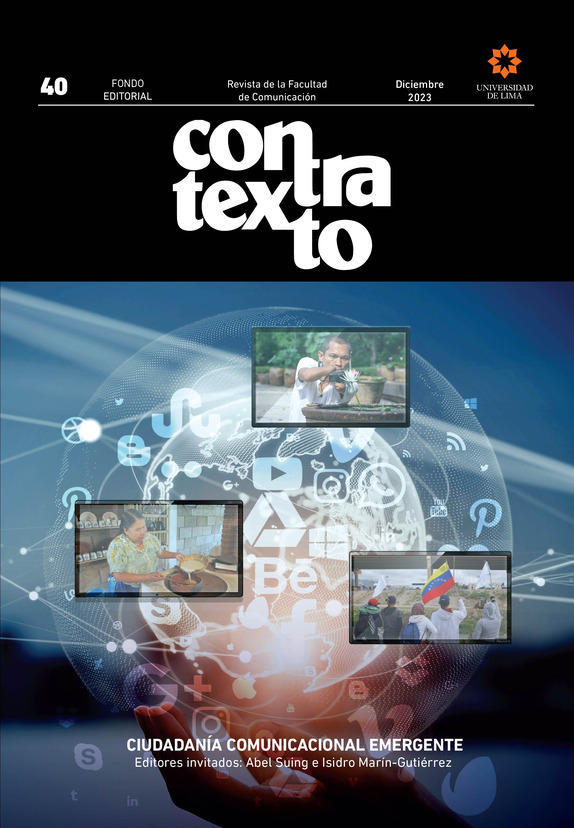Experiencia y teoría en las decisiones publicitarias entre directivos de marketing
DOI:
https://doi.org/10.26439/contratexto2023.n40.6265Palabras clave:
publicidad, toma de decisiones, decisiones publicitarias, directivos de marketingResumen
Los directivos de marketing toman constantes decisiones relativas a la publicidad. Sin embargo, escasa literatura ha examinado su entendimiento sobre cómo funciona la publicidad. Este estudio analiza si el razonamiento subyacente en las decisiones publicitarias de los directivos de marketing se basa o es concordante con lo reportado en la literatura científica sobre el funcionamiento y efectividad publicitaria. Se llevó a cabo un análisis cualitativo y una técnica de análisis de codificación estructural, basados en las proposiciones de un metaanálisis sobre efectividad publicitaria centrado en los insumos y resultados de la publicidad. Los datos se obtuvieron mediante entrevistas con directores de marketing de diversos sectores. Los hallazgos indican que el razonamiento subyacente a las decisiones se basa en la experiencia profesional y en suposiciones implícitas, sin necesidad de respaldar su razonamiento con conocimientos procedentes de la literatura. Este estudio proporciona datos sobre el alcance en la comprensión de los directores de marketing sobre el funcionamiento de la publicidad y cómo esta comprensión influye en sus decisiones.
Descargas
Referencias
Alden, D. L., Steenkamp, J. B. E., & Batra, R. (1999). Brand positioning through advertising in Asia, North America, and Europe: the role of global consumer culture. Journal of Marketing, 63(1), 75-87. https://doi.org/10.2307/1252002
Beard, F. K. (2004). Hard-sell “killers” and soft-sell “poets”: modern advertising’s enduring message strategy debate. Journalism History, 30(3), 141. https://doi.org/10.1080/00947679.2004.12062656
Binet, L., & Field, P. (2009). Empirical generalizations about advertising campaign success. Journal of Advertising Research, 49(2), 130-133. https://doi.org/10.2501/S0021849909090163
Bogomolova, S., Szabo, M., & Kennedy, R. (2017). Retailers’ and manufacturers’ pricepromotion decisions: intuitive or evidence-based? Journal of Business Research, (76), 189-200. https://doi.org/10.1016/j.jbusres.2016.05.020
Bradley, S., Hitchon, J., & Thorson, E. (1994). Hard sell versus soft sell: a comparison of American and British advertising. En B. G. Englis (Ed.), Global and multinational advertising (pp. 141-158). Psychology Press. https://www.taylorfrancis.com/chapters/edit/10.4324/9781315799513-11/hard-sell-versus-soft-sellsandra-bradley-jacqueline-hitchon-esther-thorson?context=ubx&refId=eea2f126-ad65-4299-afe7-2e4f82aa9b84
Bruneel, J., Yli-Renko, H., & Clarysse, B. (2010). Learning from experience and learning from others: how congenital and interorganizational learning substitute for experiential learning in young firm internationalization. Strategic Entrepreneurship Journal, 4(2), 164-182.
Dahlen, M., & Rosengren, S. (2016). If advertising won’t die, what will it be? Toward a working definition of advertising. Journal of Advertising, 45(3), 334-345.
Davidsson, P., & Honig, B., (2003). The role of social and human capital among nascent entrepreneurs. Journal of Business Venturing. 18(3), 301-331. https://doi.org/10.1016/S0883-9026(02)00097-6
Daymon, C., & Holloway, I. (2010). Qualitative research methods in public relations and marketing communications. Routledge. https://doi.org/10.4324/9780203846544
Doyle, L., McCabe, C., Keogh, B., Brady, A., & McCann, M. (2020). An overview of the qualitative descriptive design within nursing research. Journal of Research in Nursing, 25(5), 443-455.
Dworkin, S. L. (2012). Sample size policy for qualitative studies using in-depth interviews. Archives of Sexual Behavior, 41(6), 1319-1320. https://doi.org/10.1007/s10508-012-0016-6
Eisend, M., & Tarrahi, F. (2016). The effectiveness of advertising: a meta-metaanalysis of advertising inputs and outcomes. Journal of Advertising, 45(4), 519-531. https://doi.org/10.1080/00913367.2016.1185981
Folkman, S., & Lazarus, R. S. (1988). Coping as a mediator of emotion. Journal of Personalityand Social Psychology, 54(3), 466-75.
Gentles, S. J., Charles, C., Ploeg, J., & McKibbon, K. (2015). Sampling in qualitative research: insights from an overview of the methods literature. The Qualitative Report, 20(11), 1772-1789. https://doi.org/10.46743/2160-3715/2015.2373
Gilbert, J. R., Stafford, M. B. R., Sheinin, D. A., & Pounders, K. (2021). The dance between darkness and light: a systematic review of advertising’s role in consumer wellbeing (1980-2020). International Journal of Advertising, 40(4), 491-528. https://doi.org/10.1080/02650487.2020.1863048
Graneheim, U. H., & Lundman, B. (2004). Qualitative content analysis in nursing research: concepts, procedures and measures to achieve trustworthiness. Nurse Education Today, 24(2), 105-112. https://doi.org/10.1016/j.nedt.2003.10.001
Guest, G., Namey, E., & Chen, M. (2020). A simple method to assess and report thematic saturation in qualitative research. PloS ONE, 15(5). https://doi.org/10.1371/journal.pone.0232076
Haugtvedt, C. P., Petty, R. E., & Cacioppo, J. T. (1992). Need for cognition and advertising: understanding the role of personality variables in consumer behavior. Journal of Consumer Psychology, 1(3), 239-260. https://richardepetty.com/wp-content/uploads/2019/01/1992-jcp-haugtvedt-petty-cacioppo.pdf
Hofacker, C. F., & Belanche, D. (2016). Eight social media challenges for marketing managers. Spanish Journal of Marketing-ESIC, 20(2), 73-80. https://doi.org/10.1016/j.sjme.2016.07.003
Johansson, J. K. (1994). The sense of “nonsense”: japanese TV advertising. Journal of Advertising, 23(1), 17-26. https://doi.org/10.1080/00913367.1994.10673428
Kim, B. J., Singh, V., & Winer, R. S. (2017). The Pareto rule for frequently purchased packaged goods: an empirical generalization. Marketing Letters, (28), 491-507.https://doi.org/10.1007/s11002-017-9442-5
Lin, C. A. (2001). Cultural values reflected in Chinese and American television advertising. Journal of Advertising, 30(4), 83-94. https://doi.org/10.1080/00913367.2001.10673653
Luce, M. F. (1998). Choosing to avoid: coping with negatively emotion-laden consumer decisions. Journal of Consumer Research, 24(4), 409-433. https://doi.org/10.1086/209518
Lynn, M. (2019). How hospitality brands grow: what hospitality marketers should know about Andrew Ehrenberg’s work. International Journal of Hospitality Management, (76), 70-80. https://doi.org/10.1016/j.ijhm.2018.06.006
MacInnis, D. J., & Jaworski, B. J. (1989). Information processing from advertisements: toward an integrative framework. Journal of Marketing, 53(4), 1-23.
Mollà, R. M., Bonet, R. M. B., & Climent, C. I. (2010). Propuesta de análisis fenomenológico de los datos obtenidos en la entrevista. Universitas Tarraconensis. Revista de Ciències de l’Educació, 1(1), 113-133. https://doi.org/10.17345/ute.2010.1.643
Mueller, B. (1992). Standardization vs. specialization: an examination of westernization in Japanese advertising. Journal of Advertising Research, 32(1), 15-24.
Nuscheler, D., Engelen, A., & Zahra, S. A. (2019). The role of top management teams in transforming technology-based new ventures’ product introductions into growth. Journal of Business Venturing, 34(1), 122-140. https://doi.org/10.1016/j.jbusvent.2018.05.009
Nyilasy, G., & Reid, L. N. (2009). Agency practitioner theories of how advertising works. Journal of Advertising, 38(3), 81-96. https://doi.org/10.2753/JOA0091-3367380306
Okazaki, S., Mueller, B., & Taylor, C. R. (2010). Global consumer culture positioning: testing perceptions of soft-sell and hard-sell advertising appeals between U.S. and Japanese consumers. Journal of International Marketing, 18(2), 20-34. http://dx.doi.org/10.2307/20750809
Palinkas, L. A., Horwitz, S. M., Green, C. A., Wisdom, J. P., Duan, N., & Hoagwood, K. (2015). Purposeful sampling for qualitative data collection and analysis in mixed method implementation research. Administration and Policy in Mental Health and Mental Health Services Research, 42(5), 533-544.
Patton, M. Q. (2002). Two decades of developments in qualitative inquiry: a personal, experiential perspective. Qualitative Social Work, 1(3), 261-283. https://doi.org/10.1177/1473325002001003636
Perkins, W. S., & Rao, R. C. (1990). The role of experience in information use and decision making by marketing managers. Journal of Marketing Research, 27(1), 1-10. https://doi.org/10.2307/3172546
Polit, D. F., & Beck, C. T. (2017). Essentials of nursing research: appraising evidence for nursing practice (9.ª ed.). Lippincott Williams & Wilkins.
Read, S., Dew, N., Sarasvathy, S. D., Song, M., & Wiltbank, R. (2009). Marketing under uncertainty: the logic of an effectual approach. Journal of Marketing, 73(3), 1-18.
Rosengren, S., Eisend, M., Koslow, S., & Dahlen, M. (2020). A meta-analysis of when and how advertising creativity works. Journal of Marketing, 84(6), 39-56. https://doi.org/10.1177/0022242920929288
Rossiter, J. R., & Percy, L. (1980). Attitude change through visual imagery in advertising. Journal of Advertising, 9(2), 10-16. https://doi.org/10.1080/00913367.1980.10673313
Saldaña, J. (2013). The Coding Manual for Qualitative Researchers. SAGE.
Sharp, B. (2016). How brands grow. What marketers don’t know. Oxford University Press.
Sharp, B., & Wind, Y. J. (2009). Today’s advertising laws: will they survive the digital revolution? Journal of Advertising Research, 49(2), 120-126. http://dx.doi.org/10.2501/S002184990909014X
Sharp, B., Wright, M., Dawes, J., Driesener, C., Meyer-Waarden, L., Stocchi, L., & Stern, P. (2012). It’s a dirichlet world: modeling individuals’ loyalties reveals how brands compete, grow, and decline. Journal of Advertising Research, 52(2), 203-213. https://doi.org/10.2501/JAR-52-2-203-213
Singh, S. N., & Cole, C. A. (1993). The effects of length, content, and repetition on television commercial effectiveness. Journal of Marketing Research, 30(1), 91-104. https://doi.org/10.2307/3172516
Sussman, K. L., Bright, L. F., & Wilcox, G. B. (2021). More is (not always) better: a multi-year analysis of advertising effects on ad recall. Journal of Marketing Development and Competitiveness, 15(4), 1-14.
Tarka, P. (2018). The views and perceptions of managers on the role of marketing research in decision making. International Journal of Market Research, 60(1), 67-87. https://doi.org/10.1177/1470785317744854
Vakratsas, D., & Ambler, T. (1999). How advertising works: ¿what do we really know? Journal of Marketing, 63(1), 26-43. https://doi.org/10.2307/1251999.
Wang, Y. Y., Jaw, J. J., Pinkleton, B. E., & Morton, C. (1997). Toward the understanding of advertising appeals in Taiwanese magazine ads and its implications. Competitiveness Review: An International Business Journal, 7(1), 46-61. https://doi.org/10.1108/eb046345
Wierenga, B. (2002). On academic marketing knowledge and marketing knowledge that marketing managers use for decision-making. Marketing Theory, 2(4), 355-362. https://doi.org/10.1177/147059310200200405
Wierenga, B. (2011). Managerial decision making in marketing: the next research frontier. International Journal of Research in Marketing, 28(2), 89-101. https://doi.org/10.1016/j.ijresmar.2011.03.001
Yin, R. K. (2017). Case study research and applications. SAGE.
Yli-Renko, H., Denoo, L., & Janakiraman, R. (2020). A knowledge-based view of managing dependence on a key customer: survival and growth outcomes for young firms. Journal of Business Venturing, 35(6). https://doi.org/10.1016/j.jbusvent.2020.106045
Young, D. S., & Casey, E. A. (2019). An examination of the sufficiency of small qualitative samples. Social Work Research, 43(1), 53-58. https://doi.org/10.1093/swr/svy026
Zeithaml, V. A., Jaworski, B. J., Kohli, A. K., Tuli, K. R., Ulaga, W., & Zaltman, G. (2020). A theories-in-use approach to building marketing theory. Journal of Marketing, 84(1), 32-51. https://doi.org/10.1177/0022242919888477
Publicado
Número
Sección
Licencia
Todos los trabajos publicados están sujetos a una licencia CC BY 4.0 Creative Commons (actualizado el 1 de marzo de 2021).
El contenido de la revista se puede compartir en cualquier material o formato. Asimismo, se puede adaptar, contribuir y transformar. Ambas posibilidades sólo están permitidas en la medida en que cumplan las siguientes condiciones:
- Atribución: Se debe otorgar crédito donde sea debido, proporcionar un enlace a la licencia e indicar los cambios en caso se realice alguno. Esto debe hacerse de la manera que se considere apropiada, sin sugerir que el licenciante lo promueva a usted o su uso del material.
Derechos de propiedad
Los derechos patrimoniales de Contratexto se publican bajo una licencia Creative Commons BY 4.0, lo que permite a los autores mantener los derechos patrimoniales de su obra sin restricciones.
Si un trabajo publicado en Contratexto fuera copiado, distribuido, difundido o cualquier otra actividad contemplada en la licencia antes mencionada, se deberá mencionar de manera visible y expresa al autor o autores y a la revista.
Auto-archivo
Esta revista permite y anima a los autores/as a publicar artículos enviados a la revista en sus sitios web personales o en depósitos institucionales, tanto antes como después de su publicación en esta revista, siempre y cuando proporcionen información bibliográfica que acredite, si procede, su publicación en ella.


















